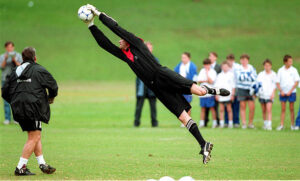
Football goalkeeping techniques are essential for aspiring goalkeepers to excel on the field. Mastering these skills enhances individual performance and significantly contributes to the team’s overall success.
Football Goalkeeping Techniques
1. Fundamental Handling Techniques
Effective ball handling is crucial for goalkeepers. The primary techniques include:
Scoop (or “Ramp”): Used for low balls approaching the keeper. The goalkeeper bends their knees, gets their body behind the ball, and scoops it up with their hands, ensuring secure possession.
Cup (or “Basket”): Ideal for mid-level shots. The keeper forms a basket with their hands, elbows slightly bent, to catch and secure the ball against their chest.
W’s (or “V’s”): Applied for high shots. The hands form a ‘W’ shape with thumbs and index fingers touching, providing a solid barrier to catch the ball above the head.
Diving (or “Hands Leading”): Essential for reaching balls out of immediate range. The goalkeeper leads with their hands, propelling their body towards the ball to make the save.
Read Also: Football Match Betting Strategies
2. Positioning and Footwork
Proper positioning allows goalkeepers to cover the goal effectively. Staying on the balls of their feet, with feet shoulder-width apart, enables quick lateral movements. Maintaining a slight forward lean keeps the body weight ready to react to shots from various angles.
3. Shot-Stopping Techniques
Collapse Dive: When there’s limited time to move, the collapse dive allows the keeper to quickly reach low shots by collapsing their body sideways, extending arms towards the ball.
Parrying and Punching: For powerful shots or crosses that are difficult to catch, goalkeepers can use their fists to punch the ball away from danger, ensuring it doesn’t remain in a threatening area.
4. Distribution Skills
A goalkeeper’s role extends beyond shot-stopping; initiating attacks is equally important. Techniques include:
Throwing: Accurate and quick throws can launch counter-attacks. The side-arm throw, or “sidewinder,” provides speed and precision.
Punting: When a more extended distribution is needed, a well-executed punt sends the ball deep into the opponent’s half, allowing the team to advance.
5. Communication and Command
Goalkeepers must effectively communicate with their defenders, organizing the backline and calling out instructions. A commanding presence instills confidence in the defense and helps prevent defensive lapses.
6. Mental Resilience and Decision-Making
The ability to make quick decisions under pressure is vital. The situation depends on whether to catch, punch, or stay on the line. Mental resilience ensures goalkeepers remain focused throughout the match, even after setbacks.
7. Training Drills for Improvement
Regular practice of specific drills enhances goalkeeping techniques:
Three-Cone Drill: Improves agility and reaction time. Set up three cones before the goal; the goalkeeper moves to the designated cone and returns to the center to catch a shot.
Bounce Reaction Drill: Enhances reflexes for unpredictable ball movements. A partner throws the ball to bounce before reaching the keeper, who must react quickly to secure it.
8. Adapting to Modern Game Demands
Modern football requires goalkeepers to be adept with their feet, participating in building play from the back. However, balancing this with traditional goalkeeping skills is crucial to avoid errors leading to goals.
In conclusion, mastering football goalkeeping techniques involves physical skills, mental toughness, and continuous practice. By focusing on these areas, goalkeepers can enhance their performance and significantly contribute to their team’s success.